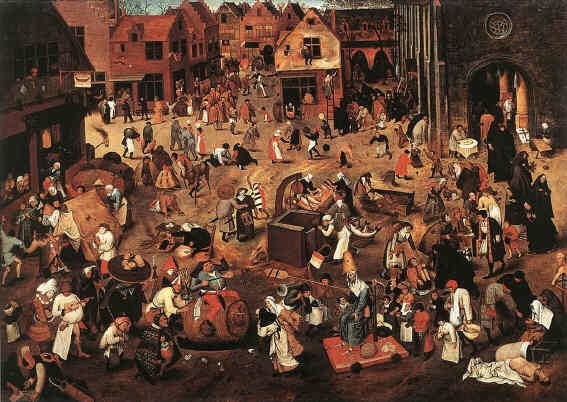To mark Shrovetide this week’s picture is Pieter Bruegel the Elder’s teeming panorama of sixteenth-century life, The Fight Between Carnival and Lent, which was painted in 1569 and can be found in the Kunsthistorisches Museum in Vienna.
The setting is the main square of an unspecified Flemish town. For all the fascinatingly minute detail of the painting (its nearly two hundred individual figures mean that a magnifying glass, or even microscope, is needed when looking at it in reproduction) everything is subordinated to a single guiding theme. The artist’s subject is a threshold between two cycles in the liturgical calendar, the moment when the last feast of winter must give way to Lenten fasting. Self-indulgence, hilarity and excess are set against self-denial and sobriety: a conflict epitomised by the mock battle taking place in the foreground of the picture, where two figures on floats, comically dressed up to embody Carnival and Lent respectively, are propelled towards each other by their followers like the combatants in a parodic joust.
The literal meaning of Carnival is “farewell to meat”, from the Latin carnem levare. Its origins are murky but may lie in the Roman Saturnalia, although it was only in the later Middle Ages that it became an established end-of-winter festival, allowing the people at large a brief moment of gluttony, laughter, drunkenness and controlled (sometimes barely controlled) anarchy before the penitential and ascetic rituals of Lent, shadowed by the solemn awareness of Christ’s crucifixion. Bruegel’s Carnival and Lent offers among other things a fascinating compendium of folkloric custom. The figure of Carnival himself, appropriately corpulent, sits astride a beer barrel with a pork chop attached to its front end and a cooking pot hanging from its side as an improvised stirrup. His helmet is a meat pie, his lance...


